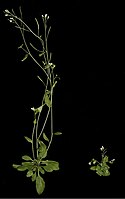
Integrated analysis of miRNAs and their targets reveals that miR319c/TCP2 regulates apical bud burst in tea plant (Camellia sinensis)
Sign Up to like & getrecommendations! Published in 2019 at "Planta"
DOI: 10.1007/s00425-019-03207-1
Abstract: Main conclusionThe roles of microRNA-mediated epigenetic regulation were highlighted in the bud dormancy–activity cycle, implying that certain differentially expressed miRNAs play crucial roles in apical bud burst, such as csn-miR319c/TCP2.AbstractmicroRNAs (miRNAs) are a class of… read more here.
Keywords: bud; bud burst; burst; tea plant ... See more keywords

Effects of shading on lignin biosynthesis in the leaf of tea plant (Camellia sinensis (L.) O. Kuntze)
Sign Up to like & getrecommendations! Published in 2020 at "Molecular Genetics and Genomics"
DOI: 10.1007/s00438-020-01737-y
Abstract: Shading can effectively reduce photoinhibition and improve the quality of tea. Lignin is one of the most important secondary metabolites that play vital functions in plant growth and development. However, little is known about the relationship between… read more here.
Keywords: plant; shading lignin; tea plant; shading treatments ... See more keywords

Identification and Expression Analysis of the SBP-box Gene Family Related to Abiotic Stress in Tea Plant (Camellia sinensis (L.) O. Kuntze)
Sign Up to like & getrecommendations! Published in 2021 at "Plant Molecular Biology Reporter"
DOI: 10.1007/s11105-021-01306-6
Abstract: SQUAMOSA promoter binding protein (SBP)-box proteins are plant-specific transcription factors (TFs) and play crucial roles in a variety of physiological processes, including plant growth and development, signal transduction, and stress response. However, SBP-box family genes… read more here.
Keywords: tea plant; sbp box; plant;

Identification of MTP gene family in tea plant (Camellia sinensis L.) and characterization of CsMTP8.2 in manganese toxicity.
Sign Up to like & getrecommendations! Published in 2020 at "Ecotoxicology and environmental safety"
DOI: 10.1016/j.ecoenv.2020.110904
Abstract: Cation diffusion facilitators (CDFs) play central roles in metal homeostasis and tolerance in plants, but the specific functions of Camellia sinensis CDF-encoding genes and the underlying mechanisms remain unknown. Previously, transcriptome sequencing results in our… read more here.
Keywords: sinensis; csmtp8; manganese toxicity; tea plant ... See more keywords

Blister blight a threatened problem in tea industry: A review
Sign Up to like & getrecommendations! Published in 2020 at "Journal of King Saud University - Science"
DOI: 10.1016/j.jksus.2020.09.008
Abstract: Abstract Tea is one of the most consumed beverages and is produced from the tender leaves of the tea plant. Various biotic and abiotic factors are directly related to tea productivity. Among the biotic factors… read more here.
Keywords: blister blight; tea plant; tea; blight threatened ... See more keywords

TMT-based quantitative proteomics analysis reveals the response of tea plant (Camellia sinensis) to fluoride.
Sign Up to like & getrecommendations! Published in 2018 at "Journal of proteomics"
DOI: 10.1016/j.jprot.2018.02.001
Abstract: The tea plant is a fluoride hyperaccumulator, and fluoride accumulation in its leaves is closely related to human health. To dissect molecular mechanisms underlying fluoride accumulation/detoxification, the leaves of tea seedlings exposed to different fluoride… read more here.
Keywords: fluoride accumulation; plant; tea plant; tea ... See more keywords

Differential transcriptomic changes in low-potassium sensitive and low-potassium tolerant tea plant (Camellia sinensis) genotypes under potassium deprivation
Sign Up to like & getrecommendations! Published in 2019 at "Scientia Horticulturae"
DOI: 10.1016/j.scienta.2019.108570
Abstract: Abstract Potassium (K) deficiency is a common abiotic stress that can inhibit plant growth and thus reduce crop productivity. K shortages in tea farms are very severe in current tea production systems. Therefore, developing low-K… read more here.
Keywords: potassium; tea plant; low potassium; tea ... See more keywords

Evaluation and selection of suitable qRT-PCR reference genes for light responses in tea plant (Camellia sinensis)
Sign Up to like & getrecommendations! Published in 2021 at "Scientia Horticulturae"
DOI: 10.1016/j.scienta.2021.110488
Abstract: Abstract Tea plant (Camellia sinensis) is an important woody economic crop used for processing leaf-type beverages. Numerous studies have shown that light is a necessary environmental condition to control the growth and metabolism of C.… read more here.
Keywords: expression; tea plant; sinensis; plant camellia ... See more keywords

Metabolites and Transcriptional Profiling Analysis Reveal the Molecular Mechanisms of the Anthocyanin Metabolism in the "Zijuan" Tea Plant (Camellia sinensis var. assamica).
Sign Up to like & getrecommendations! Published in 2020 at "Journal of agricultural and food chemistry"
DOI: 10.1021/acs.jafc.0c06439
Abstract: Anthocyanins are natural colorants that have attracted increasing attention because of their extensive range of antioxidant, antimutagenic, and health-promoting properties. The mechanism of anthocyanin synthesis has been studied in "Zijuan" tea, a representative anthocyanin-rich tea… read more here.
Keywords: anthocyanin metabolism; anthocyanin; tea plant; tea ... See more keywords

Relationship between Secondary Metabolism and miRNA for Important Flavor Compounds in Different Tissues of Tea Plant (Camellia sinensis) As Revealed by Genome-Wide miRNA Analysis.
Sign Up to like & getrecommendations! Published in 2021 at "Journal of agricultural and food chemistry"
DOI: 10.1021/acs.jafc.0c07440
Abstract: This study investigated the regulatory relationship between important flavor compounds and microRNA (miRNA) in nine different tissues of tea plant by analyzing the related metabolites, small RNAs (sRNAs), degradome, and coexpression network. A total of… read more here.
Keywords: tissues tea; flavor compounds; different tissues; tea plant ... See more keywords

Nitrogen-Regulated Theanine and Flavonoid Biosynthesis in Tea Plant Roots: Protein-Level Regulation Revealed by Multiomics Analyses.
Sign Up to like & getrecommendations! Published in 2021 at "Journal of agricultural and food chemistry"
DOI: 10.1021/acs.jafc.1c02589
Abstract: Theanine and flavonoids (especially proanthocyanidins) are the most important and abundant secondary metabolites synthesized in the roots of tea plants. Nitrogen promotes theanine and represses flavonoid biosynthesis in tea plant roots, but the underlying mechanism… read more here.
Keywords: plant roots; tea plant; tea; flavonoid biosynthesis ... See more keywords